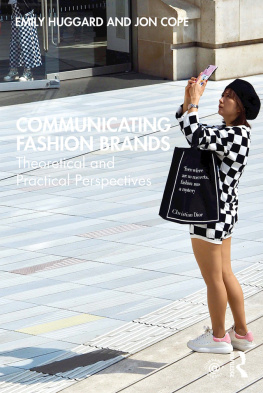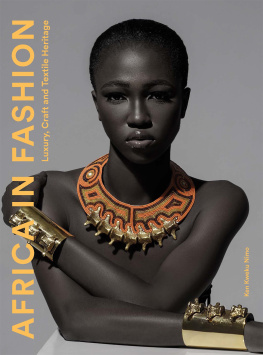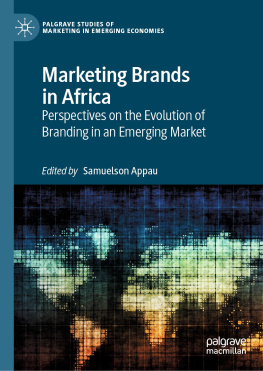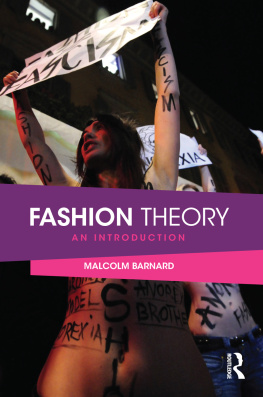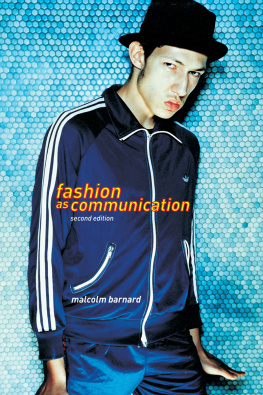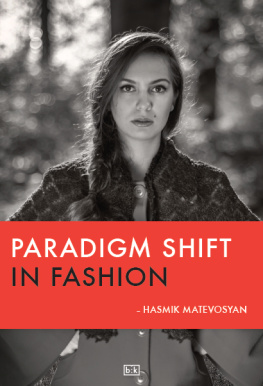Communicating Fashion Brands
This book demonstrates how fashion brands communicate, why the practice is significant within wider society and how it can be perceived as culturally meaningful.
Enabling readers to connect the tools and techniques of communication with their theoretical underpinnings and historical antecedents, the book shows how these methods can be applied in practice. The authors utilise social, consumer and cultural theory, and frameworks rooted in psychology, sociology and economics, as mechanisms to analyse and deconstruct current communication strategies used by fashion brands. The book presents insights and strategies for communicating authentic values, conveying a clearly defined aesthetic and visual language and generating shareable content that resonates with audiences. With insights into strategies used by brands including Burberry, Gucci, Dior, COS, Rapha, Warby Parker and Maryam Nassir Zadeh, each chapter outlines ways of maintaining relevant and consistent brand narratives in the 21st century. From how to sustain a dialogue with a brands community, to the use of brand collaboration, co-creative storytelling and fashion spaces, the book aims to develop reflective communication practitioners who have a deep understanding of the cultural landscape, brand strategy and industry innovation.
Written for scholars and practitioners, this book is a valuable blend of theory and practice across the fields of fashion, communication and branding.
Emily Huggard is Assistant Professor of Fashion Communication at Parsons School of Design in New York. Her research explores how brands create a space of proximity for the consumer using physical, digital and social realms, and the use of installation art as a brand experience tool in the epoch of post-consumerism and post-digital.
Jon Cope leads the MA in Public Relations at Westminster University in London. His current research focuses on the use of visual materials in promotional communication. Jon co-authored and photographed the book Fashion Promotion in Practice, published in 2016. He holds an MA in Critical Global Politics from Exeter University.
Communicating Fashion Brands
Theoretical and Practical Perspectives
EmilyHuggardandJonCope
First published 2020
by Routledge
2 Park Square, Milton Park, Abingdon, Oxon OX14 4RN
and by Routledge
52 Vanderbilt Avenue, New York, NY 10017
Routledge is an imprint of the Taylor & Francis Group, an informa business
2020 Emily Huggard and Jon Cope
The right of Emily Huggard and Jon Cope to be identified as authors of this work has been asserted by them in accordance with sections 77 and 78 of the Copyright, Designs and Patents Act 1988.
All rights reserved. No part of this book may be reprinted or reproduced or utilised in any form or by any electronic, mechanical, or other means, now known or hereafter invented, including photocopying and recording, or in any information storage or retrieval system, without permission in writing from the publishers.
Trademark notice: Product or corporate names may be trademarks or registered trademarks, and are used only for identification and explanation without intent to infringe.
British Library Cataloguing-in-Publication Data
A catalogue record for this book is available from the British Library
Library of Congress Cataloging-in-Publication Data
Names: Huggard, Emily, editor. | Cope, Jon, editor.
Title: Communicating fashion brands: theoretical and practical
perspectives / Emily Huggard and Jon Cope.
Description: London; New York: Routledge, 2020. | Includes
bibliographical references and index.
Identifiers: LCCN 2019044138 (print) | LCCN 2019044139 (ebook)
Subjects: LCSH: AdvertisingFashion. | Fashion merchandising. |
Branding (Marketing)
Classification: LCC HF6161.C44 .C66 2020 (print) |
LCC HF6161.C44 (ebook) | DDC 659.19/74692dc23
LC record available at https://lccn.loc.gov/2019044138
LC ebook record available at https://lccn.loc.gov/2019044139
ISBN: 978-1-138-61355-3 (hbk)
ISBN: 978-1-138-61356-0 (pbk)
ISBN: 978-0-429-46442-3 (ebk)
Typeset in Sabon
by Apex CoVantage, LLC
Visit the companion website: www.communicatingfashion.com
The fashion industry is in a constant state of change. Innovation in technology (big data, artificial intelligence), digital and social media have led to an open, fluid dialogue between fashion brands and their audiences, leading to the co-creation of brand stories and value.
Once siloed into individually planned channels or units of conversation (retail, marketing, advertising, public relations) brand communication strategies must now be fully integrateduniting various media, tools and platforms in order to avoid audience fragmentation, maintain cultural relevance, and create seamless and transparent brand narratives.
Fashion brands are no longer defined solely by their product. We have witnessed a move away from traditional sales-focused and brick-and-mortar retail to temporary and installation-based brand spaces that offer immense opportunities for personalised and meaningful communications and experiences. With the emergence of new business models and systems (e.g. direct-to-consumer, rental and consignment, open-source, and experiential) fashion brand communicators now work with a new breed of emergent designers and brands in telling their stories (e.g. sustainable or human rights focused) in ways that are inspiring and exciting to the market and capture the imagination of audiences.
This book offers the reader the opportunity to understand fashion brand communication from both a theoretical and practical perspective. It presents insights into, and strategies for, generating brand initiatives and strategies that communicate authentic values, convey a clearly defined aesthetic and visual language and generate shareable content that resonates with audiences.
Our approach relates cultural theory and historical studies to current industry practice, where theory is understood as a general principle or body of principles offered to explain phenomena. Each chapter utilises social, consumer and cultural theory and frameworks, rooted in psychology, sociology and economics, as mechanisms with which to analyse and deconstruct current communication strategies used by fashion brands.
Despite the availability of several fashion-specific marketing and branding textbooks, there remains a focus on brand communication at an operational or tactical level, rather than at a strategic level. This book provides the opportunity for readers to understand the whythe deeper meaning, thought and logic behind the decisions made in developing fashion brand communication campaigns and strategies. This understanding is a crucial aspect of becoming a reflective practitioner who challenges current systems and thinking. Relating theory to practice helps the reader understand and analyse the social and cultural attributes of fashion brand communication, as well as what makes a brands approach successful and relevant.
While each chapter focuses on a different brand case study, the common thread between each is the role of the fashion brand communicator as a cultural intermediary who meaningfully responds to and shapes culture, and builds cultural credibility around the brands that they work with.

